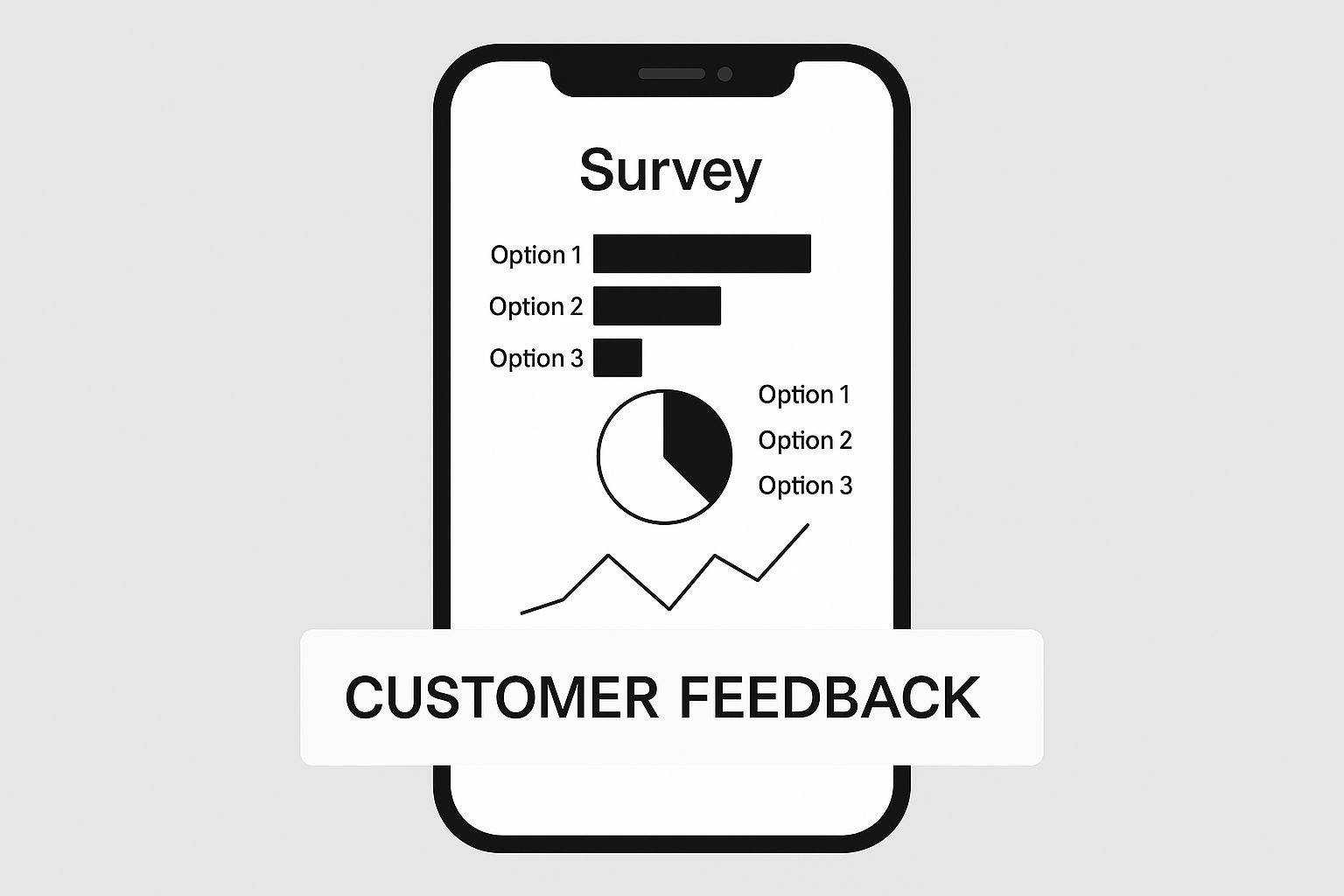validating a business idea
startup validation
business testing
market research
MVP development
Validating a Business Idea: Your Complete Success Roadmap
Why Validating a Business Idea Is Non-Negotiable
It's common for new entrepreneurs to cherish a fantastic idea, sometimes hesitating to put it through the vital test of validating a business idea. While this reluctance makes sense, skipping this step can quickly lead to letdown. Starting a business is thrilling, but it's a path full of challenges if you don't proceed thoughtfully.
The hard truth is, most new businesses don't make it, which is why idea validation acts as a crucial safeguard. Recent figures on startup failures are quite revealing: studies show that as many as 90% of startups fail in total. Out of these, 10% close down within their first year, and a significant 70% fail between their second and fifth years. This trend has held steady for at least the last five years, highlighting the danger of moving too quickly without proper groundwork. You can find more detailed statistics on startup failures at Exploding Topics.
These statistics point to an important fact: going to market without checking if people actually want your product is a risky bet with high stakes. So, what makes so many founders bypass this essential stage? Usually, it’s a combination of strong faith in their idea and a keen desire to see it realized, causing them to accidentally ignore the serious downsides. Recognizing these potential problems is key to building a smarter plan.
The Real Costs of Launching Blind
Jumping into the market without first validating a business idea can seriously empty your pockets. Think about spending months, or even years, plus a lot of money to create something, only to discover that customers aren't interested in buying it. This typically leads to:
- Wasted development costs: Money and effort spent on features no one uses.
- Ineffective marketing spend: Budgets used trying to attract people who aren't interested.
- Lost personal investment: Your own savings or loans disappearing without any profit.
Aside from the financial hit, the emotional impact of a business not working out can be crushing. When you've put so much passion and energy into a startup concept, failure feels very personal. This can result in:
- Intense stress and burnout from dealing with constant unknowns and difficulties.
- A loss of confidence and drive for any new projects.
- Strained personal relationships because of the stress from a failing business.
Here, the approach of new founders often differs from that of experienced entrepreneurs. Those who have found success understand that validating a business idea isn't meant to shoot down their vision, but to polish it. They use methodical validation as a way to gather insights, make adjustments, and improve their odds of creating something genuinely worthwhile and lasting.
In the end, the work of validating a business idea is much more than just a step to tick off a list. It signifies a core change from running on hope to operating with a strategy based on facts. It’s the critical difference between a business set up for expansion and one that turns into a costly, though instructive, lesson. Adopting validation early on can turn your initial thought into a real contender for market success.
The Hidden Costs of Skipping Business Validation

While the financial and emotional setbacks of a failed business are substantial, the consequences of sidestepping the essential step of validating a business idea often go further and aren't immediately obvious. Enthusiastic founders, driven by their vision, sometimes rush into the market, only to face difficult realities when it's very late in the game. This lack of foresight can trigger a series of issues, even for ventures that have secured significant funding.
When Assumptions Collide with Reality
Many promising startups, even those with every seeming advantage, have unfortunately failed because they skipped proper market validation. Founders might genuinely believe they have a deep understanding of their target customers, only to discover their assumptions were incorrect. For example, a well-funded tech company might develop a product packed with features based on internal discussions, without checking if these features address a genuine customer need. The outcome is often a technically sound solution that no one is looking for, resulting in wasted resources and a disinterested market. These situations show a common problem: strong belief in an idea without the support of real-world evidence obtained through validating a business idea.
Lessons Learned in Hindsight: The Regret of Skipped Steps
Overlooking early warning signs or common errors during the initial stages can have devastating effects. Some of these frequent missteps include:
- Confirmation bias: Actively looking for information that supports what you already believe about the business idea.
- Insufficient research: Depending on personal stories or limited observations instead of comprehensive market analysis.
- Ignoring negative feedback: Brushing aside critical comments received during early-stage testing.
A feeling of regret for not laying a stronger foundation is common among founders whose ventures did not succeed. Recent studies show that a notable 58% of failed startup founders expressed wishing they had conducted more idea validation research. Furthermore, another 58% wished they had developed a more robust business plan, highlighting the significant effect of careful preparation. You can Discover more insights about startup founder regrets and business planning from Winsavvy. This information clearly indicates that the short-term effort of thorough validation is a minor inconvenience compared to the enduring hardship of a failed business built on untested beliefs. Validating a business idea carefully is truly an investment in its long-term viability.
Understanding the Critical Need for Validating a Business Idea
So, you understand that validating a business idea is a crucial first step. Now, it's time to get familiar with practical strategies that actually give you solid feedback. Let's move past the theories and look at methods that have proven their worth for entrepreneurs looking to see if their ideas have real market appeal.
One of the most important parts of this validation journey is customer feedback, which is often collected through online tools. The image below shows how things like digital survey forms and direct feedback options on smartphones are central to validating a business idea.

This image highlights just how vital direct communication with potential customers and careful data gathering are. These feedback loops are incredibly useful for tweaking your business concept before you pour significant resources into it.
Key Validation Tactics Explored
When it comes to validating a business idea, a few methods really shine. For instance, landing page tests are a very common and effective way to gauge initial interest. These aren't just guesses; landing page tests show a 68% validation success rate for B2C startups. It's widely seen as one of the quickest and most budget-friendly ways to check for demand before you build out a full product. You can explore this topic further and see more validation statistics to get a deeper understanding.
Another powerful technique is conducting structured customer interviews. These conversations help you gather rich, qualitative information. They let you dig deeper than just surface-level interest, allowing you to truly understand the "why" behind what your customers need and what problems they face. By asking specific questions, you can uncover vital details about how potential users might behave and what they expect, making sure you’re actually solving a genuine problem.
Designing Effective Validation Experiments
To get genuine market insights and avoid misleading positive signals, it's essential that your validation experiments are thoughtfully designed. This begins with creating clear, testable hypotheses about who your target audience is, the specific problem your idea addresses, and how your solution fits in. Every experiment should be set up to either confirm or disprove a particular assumption with results you can actually measure.
As you look into different ways for validating your business idea, remember how important a good plan is. This article on Strategic Planning offers insights into creating a well-structured approach, which can be very helpful for how you frame your experiments. Thinking in this organized way will assist you in correctly interpreting mixed signals and steering clear of common pitfalls that can lead to wrong conclusions about your business concept.
Choosing Your Validation Approach
Picking the best method for validating a business idea really comes down to your unique circumstances. Think about your type of business, the resources you have available, and how far along your idea is.
To help you decide, here's a table that provides a comprehensive comparison of different validation methods, their success rates, time investment, and cost requirements.
Business Idea Validation Methods Comparison
| Validation Method | Success Rate Indicator | Time Required | Cost Level | Best For |
|---|---|---|---|---|
| Landing Page Test | High | Low-Medium | Low | Testing value proposition, gauging initial demand |
| Customer Interviews | Medium-High | Medium | Low-Medium | Deep understanding of customer pain points |
| Surveys | Medium | Low | Low | Quantifying interest, demographic insights |
| Pre-orders/Crowdfunding | High (if successful) | Medium-High | Medium | Validating willingness to pay, market demand |
| Concierge MVP | Medium-High | Medium | Medium | Testing service-based ideas, direct feedback |
This comparison should give you a clearer picture of how to sequence your validation activities to learn the most while spending the least. If you're looking for more tools, you might be interested in learning how to use a startup idea validator tool to further assess your concept.
Ultimately, the aim is to collect enough solid evidence. This will help you make a well-informed decision on whether to move forward with your idea, adjust your approach, or perhaps put it on hold.
Building Your MVP for Maximum Market Learning
Your Minimum Viable Product (MVP) isn't just a basic version of your final offering; it’s a powerful tool for validating a business idea. The main job of an MVP is to test your most critical, uncertain assumptions about your potential customers and the problem you're trying to solve. It provides a direct channel for market feedback.
This way of validating a business idea means shifting your focus. Instead of just building a product, you’re constructing a learning mechanism. The aim is to get useful data with the minimum development work and financial outlay.
Designing MVPs for Meaningful Validation Data
To effectively use an MVP for validating a business idea, your design needs to concentrate on testing your "leap of faith" assumptions. These are the core beliefs that, if wrong, could sink your entire project. This means you need to clearly identify what you must learn before any coding or full service design begins.
This focus helps you sidestep the common pitfall of a feature-driven mindset. That's where teams build out many features based on their own beliefs, not on actual customer needs. By putting assumption testing first, you naturally cut down on wasted development time and money, making sure every bit of effort leads to learning.
Exploring Creative MVP Formats
When validating a business idea, don't limit your thinking to just a scaled-down app. Many successful entrepreneurs have used inventive, low-effort MVP methods to check their theories. These alternative approaches can offer deep insights without the heavy lifting of full product creation.
Here are a few options to consider:
- Service-Based MVPs: For example, a "Wizard of Oz" MVP has you manually performing the service in the background while the customer thinks they're using an automated system. This tests if people actually want the service.
- Concierge MVPs: This method involves personally guiding your initial users through your solution. It's a high-touch way to deeply understand their needs and what frustrates them.
- Digital-First Strategies: A fake landing page test, which describes your product and collects sign-ups or pre-orders, can be a great way to see if there's demand. Another option is a simple explainer video that outlines your value proposition.
These techniques enable quick adjustments and learning, which is essential for validating a business idea before you make big investments.
Defining Success and Extracting Learning
The success of an MVP isn't about how polished it looks or how many features it has. It’s about the clarity of the information it provides. Before you launch your MVP, define clear success metrics that are directly linked to the assumptions you’re testing. What specific user actions or feedback will prove or disprove your key ideas?
Adopt a learning-driven mindset, seeing every customer interaction and piece of data as a chance to improve your understanding. This cycle of building, measuring, and learning is key to effectively validating a business idea. If you'd like to delve deeper, you might find our guide on the MVP development process and its intricacies helpful. There are also many established methods for validating your business idea; you can explore practical tips on how to validate business idea to expand your methods.
The ultimate goal is to extract maximum learning from every experiment, ensuring your business is built on a solid foundation of validated customer needs.
Finding and Testing Your Real Target Market

After your Minimum Viable Product (MVP) has helped check your early ideas, the next step is to figure out who really wants what you've built. This means identifying your real target market—not just a general group, but specific individuals with distinct needs and ways of buying. This stage is vital, as even the best product can fail if no one is keen to use it.
Good market research, when you're checking if your business idea will work, goes beyond simple details like age or where people live. It's about discovering genuine customer behavior, what motivates them, and the buying habits that influence their choices. Getting to grips with this "why" is key to knowing if you're heading in the right direction.
Uncovering True Customer Needs
Finding your ideal customers begins with careful listening. In fact, studies suggest that paying attention and adapting to what your audience needs can improve product-market fit by as much as 38%. This involves actively reaching out to potential users and having real conversations, frequently through customer interviews.
These customer interviews are not about selling; they're a chance to collect unfiltered, truthful feedback. The aim is to grasp their pain points and learn about their current solutions. Asking open-ended questions can unearth important details that standard surveys might not catch, a critical step in thoroughly checking your business concept.
Validating More Than Just Demand
Making sure your business idea is solid means more than just confirming people want your product. You also have to test your pricing strategies, your product's market positioning, and your plans for reaching customers—your go-to-market tactics. Will people actually pay what you're asking? Does your marketing message connect with them?
Useful methods can assist in dividing your market, helping you decide which customer groups to focus on initially. It's also very important to spot red flags quickly, like ongoing low interest from your expected audience; this could mean you’re aiming at the wrong people and might need to pivot. Responding to this kind of audience feedback is key, as businesses that do this consistently can see their conversion rates go up by as much as 30%.
Making Smart Go/No-Go Decisions With Confidence
The journey of validating a business idea eventually leads to a crucial moment: the decision point. Do you push ahead, make some changes, or stop altogether? Once you've collected all that valuable data from your Minimum Viable Products (MVPs) and market tests, you'll need a structured method to make this go/no-go decision. This isn't about gut feelings; it's about turning your research into a clear direction.
Setting Meaningful Metrics for Success
To choose wisely, you need to set up clear benchmarks for validation success right from the get-go, even before testing begins. The key is to concentrate on meaningful metrics – those that show real customer interest – not vanity metrics. Things like website visits or social media likes can easily fool you.
A strong sign of genuine interest? Think a good number of waitlist sign-ups paired with a pre-order conversion rate of 5-10%. Other valuable indicators include positive feedback from customer conversations highlighting a clear need, or how users interact with your prototype, showing it solves their problem. These numbers give you solid proof of real market demand.
Interpreting Signals and Making Tough Calls
Let's be honest, the data you gather while validating a business idea is rarely a simple yes or no. You’ll often find yourself looking at mixed messages or results that don't point clearly one way or the other. For instance, people might rave about your idea in interviews but then hesitate when it's time to pre-order.
This is where having a system to understand these signals becomes so important. It's a classic startup dilemma: knowing when to pivot (that is, make a big change to your product or business plan) versus when to persevere through a rough patch. Keep in mind, a huge 42% of product failures happen because there wasn't a real market need. Getting these interpretations right is essential. Sometimes, hearing "no" is actually a good thing, steering you away from a dead end.
Practical Frameworks for Decision Making
Putting some practical frameworks in place can make your decision-making much clearer. What does this look like?
- Setting a firm validation budget so you don't overspend while testing.
- Defining a realistic timeline to avoid getting stuck in a never-ending validation cycle.
- Creating clear decision points, or "gates," where you pause, assess, and make a call.
When you're validating a business idea, for every assumption you put to the test, spell out exactly what success means. A good way to phrase this is: "We believe that [X target audience] will [perform Y action], and we are right if [Z% achieve this metric]." This methodical way of doing things helps you make steady progress without jumping to conclusions too early.
To assist in this critical phase, it's helpful to use a clear guide. The "Validation Success Metrics Framework" detailed below offers key performance indicators and benchmarks for determining when your business idea has been sufficiently validated. This framework provides a structured approach to assess your progress.
| Metric Type | Success Benchmark | Warning Signs | Action Required |
|---|---|---|---|
| Customer Acquisition Cost (CAC) | Below projected lifetime value (LTV) by X% | CAC significantly higher than initial projections | Re-evaluate marketing channels, target audience |
| Conversion Rate (e.g., sign-ups, pre-orders) | 5-15% from targeted traffic (varies by industry) | Consistently low conversion despite iterations | Revisit value proposition, user experience, pricing |
| Engagement Metrics (e.g., active use of MVP) | High retention/repeat usage after initial trial | Quick drop-off, minimal feature interaction | Interview users to understand drop-off, iterate on MVP |
| Qualitative Feedback | Strong positive sentiment, clear problem-solution fit | Confusion, indifference, major unresolved concerns | Conduct deeper customer interviews, consider a pivot |
Relying on a framework like this one takes some of the guesswork out of the equation. It ensures you’re focusing on the data that truly matters for making those tough calls.
Making these go/no-go decisions is never a walk in the park. However, taking a systematic approach to validating a business idea, one that's built on real-world metrics and clear checkpoints, gives you the confidence to move forward. This greatly cuts down the risk of pouring resources into a product that, ultimately, no one will use.
Real-World Validation Success Stories and Lessons
It's one thing to make a decision using validation data, but it's quite another to watch that choice grow into a thriving business. Looking at how successful companies have tackled validating a business idea can give you some great starting points. These examples show off smart strategies and the big difference early, repeated testing can make.
A classic story of smart pre-launch validation is Dollar Shave Club. Rather than sinking a lot of money into stock and setup straight away, they made a simple, funny video explaining their service. Amazingly, this video went viral and brought in 12,000 orders in only 48 hours. This strongly confirmed people wanted their product before they went all-in. It just goes to show that companies using inventive ways to check their ideas often do better when competition is tough. You can find out more about how validation research makes a difference from Venture Validator.
Then there's Airbnb, another big name, which took a really straightforward path to validating their business idea. The founders famously offered air mattresses for rent in their San Francisco apartment. This happened during a design conference when all the local hotels were full. This practical test directly checked their main question: would people actually pay to sleep in someone else's place? Even though it was small, the good feedback they got early on was the vital proof they were looking for.
Actionable Insights From The Front Lines
These stories aren't just motivating; they come with some solid, practical takeaways:
- Directly Test Your Main Ideas: Both companies zeroed in on checking the most basic parts of their business concepts from the get-go, tackling the biggest uncertainties first.
- Go for Low-Budget Tests: Making a viral video or renting out your own space shows you can use cleverness instead of big spending to get answers.
- Look for Genuine Pledges: Getting pre-orders or actual bookings, even if just a few, tells you much more about real interest than just survey answers.
- Adjust Based on What You Learn: The first check is only the beginning. Keep learning and changing your product based on how real people use it – that's how you make it better.
Grasping these methods can certainly help you sharpen your own strategy for validating a business idea. It’s also super helpful to get an impartial view on your concepts when they're just starting out. For a bit of constructive criticism, you might want to check out: Getting Your Startup Idea Roasted for Constructive Feedback.
Want to speed up your AI-powered SaaS launch and skip the second-guessing? Find out how AnotherWrapper can assist you in building and testing your ideas more quickly. Visit AnotherWrapper's website to begin!
Fekri




